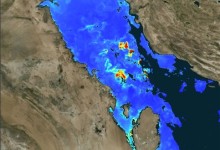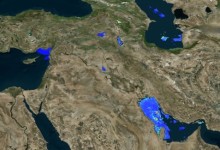Click here to view the Kuwait database
The problem of identifying and responding to algal blooms in Kuwait Bay and along its coastlines will be addressed in this project. The project will take advantage of, and build on, experience gained by the involved researchers in a current NOAA-funded study on Monitoring and Event Response for Harmful Algal Blooms (MERHAB) in Lakes Erie and Ontario. In the Great Lakes, as is the case with Kuwait Bay and coastal waters, the harmful algal blooms have occurred with greater frequency and intensity in recent years. This project will focus on developing the infrastructure and the expertise at KISR to allow mapping algal blooms in general and to develop the appropriate methodology to distinguish toxic algal blooms from blooms of other chlorophyll containing algae. The data will be generated on a near-real time basis with weather-related measurements (e.g., temperature, humidity, wind velocity, precipitation, etc.) from a weather station. The first step will be testing the available methodologies for identification of algal bloom in Kuwait territorial waters using satellite data. The most appropriate methodology will be selected, customized and verified by sea truths; the identification of dominant species during each monthly cruise and in an event of algal bloom during the entire duration of project and development of a database and web based platform for dissemination of information.
The long-term goals of this project are to increase decision-making capability for near real-time detection of algal blooms, and the ultimate development of a warning system for early detection of algal blooms in Kuwait’s coastal waters. The proposed activities will result in designing and conducting focused applied research projects on this phenomenon and will also provide new avenues for data collection in support of research proposals in areas other than aquatic remote sensing. These data are essential to conduct large-scale environmental and climate change research successfully.

